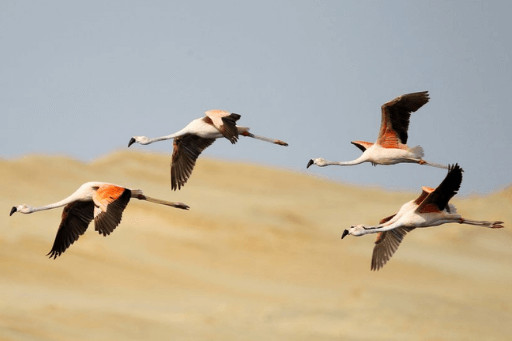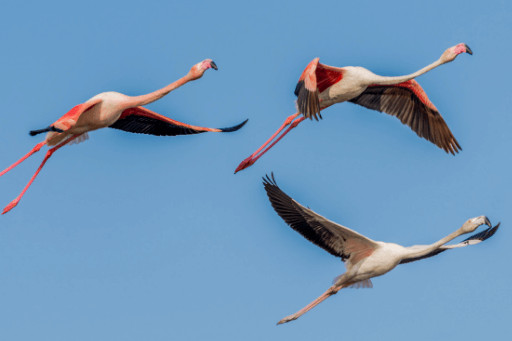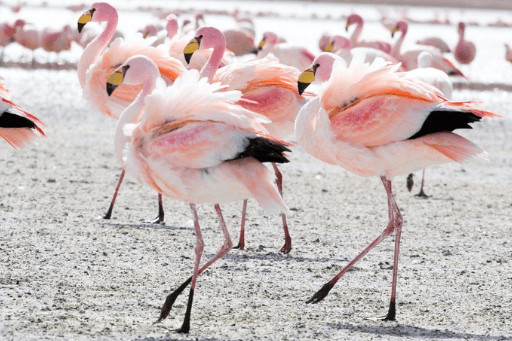Flamingos, with their striking pink plumage and elegant stature, often evoke images of exotic zoo exhibits or whimsical garden decorations. However, these magnificent creatures are much more than just pretty birds. They possess a range of fascinating capabilities, including the power of flight. Let’s delve into the world of flamingos to uncover the truth about their flying abilities, migratory habits, and conservation status.
Do Flamingos Really Fly? Dispelling the Myths
The resounding answer is yes, flamingos are indeed capable of flight. The misconception that they cannot fly often arises because flamingos in zoos frequently have their flight feathers trimmed. This practice renders them flightless, preventing escapes from their enclosures. However, in their natural habitats, all six flamingo species across the globe are adept fliers.
 Chilean Flamingos soar through the sky in a flock, demonstrating their flight capabilities. Observing flamingos in flight is a spectacular sight.
Chilean Flamingos soar through the sky in a flock, demonstrating their flight capabilities. Observing flamingos in flight is a spectacular sight.
Witnessing a flock of flamingos in flight is truly a breathtaking spectacle. These highly social birds frequently take to the skies together, often flying over serene waters that mirror their vibrant colors, creating an unforgettable visual experience.
In terms of speed, flamingos can achieve approximately 35 miles per hour (mph) during short bursts. When embarking on longer journeys, particularly with favorable winds, they can reach speeds exceeding 40 mph.
During flight, flamingos maintain a distinctive posture, extending both their legs and necks straight out. Their bills are often tilted upwards, and their wings beat continuously, propelling them through the air. They skillfully utilize prevailing winds whenever possible to conserve energy during their aerial travels.
How High Do Flamingos Fly? Exploring Flight Altitude
Flamingos are known to fly at remarkable altitudes, with observations reaching nearly 20,000 feet, especially when traversing the Andes Mountains in South America. The altitude at which flamingos fly is influenced by several factors, including wind direction and strength, as well as their intended destination. When flying over expansive oceans, they tend to maintain lower altitudes compared to flights over land.
Flamingo Migration and Flight Range: How Far Can They Go?
 Greater Flamingos fly in a classic V-formation, a technique that aids in energy conservation during long flights. These social birds often travel together.
Greater Flamingos fly in a classic V-formation, a technique that aids in energy conservation during long flights. These social birds often travel together.
Flamingos inhabiting temperate regions often undertake migrations to warmer climates outside their breeding season. For instance, the Andean Flamingo, which breeds in the high-altitude Andes, migrates to lower elevations along the Pacific coast for the winter. Flamingos are also known for their nomadic tendencies, roaming extensively in search of suitable wetlands to forage for food. The American Flamingo, for example, can travel distances of up to 50 miles in pursuit of sustenance.
Flock Dynamics: Do Flamingos Fly in Groups?
Flamingos are gregarious birds, commonly found in large flocks, with a group being poetically termed a “flamboyance.” When flying, they often adopt organized formations, typically flying in rows or the characteristic “V” formation. This V-formation flight is an energy-saving strategy. As each flamingo flaps its wings, it creates an updraft, providing lift to the birds following behind, making long-distance flight more efficient for the entire flock.
Taking Flight: How Do These Large Birds Take Off?
Despite their considerable size, flamingos are adept at taking off. They initiate flight by running across the ground or shallow water while vigorously flapping their wings. When facing strong headwinds, they can achieve lift-off with a single, powerful wing beat, showcasing their agility and strength.
Flightless Flamingos in Zoos: Why the Captivity Constraint?
As mentioned earlier, the reason flamingos in zoos often appear flightless is due to feather trimming. To prevent captive flamingos from escaping open enclosures, zoos commonly trim their flight feathers. In some instances, more permanent and controversial methods are employed, involving alterations to tendons or bones in the wings to permanently disable flight. While considered inhumane by many, these procedures are sometimes used due to their lasting effect.
Flight Frequency: How Often Do Flamingos Fly?
Flamingos are indeed frequent fliers in their natural environment. They typically undergo molting of their flight feathers gradually over extended periods. This ensures they retain their ability to fly continuously. However, in captivity, and sometimes in the wild, flamingos may molt all their flight feathers simultaneously. During this period, they become flightless for approximately three weeks while new feathers grow in.
Conservation Status: Are Flamingos Facing Threats?
Unfortunately, several flamingo species are facing conservation challenges. Among the four flamingo species found in the Americas, three are experiencing rapid population declines. The Puna and Chilean Flamingos are classified as Near Threatened, while the Andean Flamingo is listed as Vulnerable on the IUCN Red List. These species are primarily threatened by habitat loss and degradation resulting from coastal development and mining activities.
Other significant threats to flamingos include oil spills, various forms of pollution, and collisions with power lines erected near their foraging or nesting sites. Furthermore, American Flamingos and their Caribbean habitats are increasingly vulnerable to sea-level rise and the intensifying storms driven by climate change.
 Andean Flamingos, like these, face increasing threats such as habitat loss and pollution, putting their populations at risk. Conservation efforts are crucial for their survival.
Andean Flamingos, like these, face increasing threats such as habitat loss and pollution, putting their populations at risk. Conservation efforts are crucial for their survival.
Conservation Efforts: How Are Flamingos Being Protected?
Organizations like the American Bird Conservancy (ABC) and other conservation groups are actively involved in flamingo conservation across various locations.
ABC, in partnership with Aves Argentina, has played a vital role in establishing and expanding a national park to safeguard Laguna Mar Chiquita, a vast salt lake in northern Argentina. This lake is a critical habitat for Chilean, Andean, and Puna Flamingos, supporting up to a third of the entire Chilean Flamingo population during certain breeding seasons.
ABC has also extended support to the Asociación Ecosistemas Andinos (ECOAN), a Peruvian non-profit organization, in their efforts to conserve the Junín National Reserve in Peru. This reserve serves as another crucial breeding ground for Chilean Flamingos.
Through these collaborative conservation initiatives, there is hope for the future of these magnificent birds, ensuring that flamingos continue to grace our skies and wetlands for generations to come.
